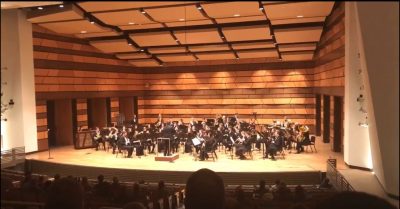 March 2, 2017 By Emma Turner – reprinted with permission from the Collegian.
March 2, 2017 By Emma Turner – reprinted with permission from the Collegian.
Patrons of music gathered in the University Center for the Arts’ Griffin Concert Hall Tuesday night to hear the Colorado State University Symphonic Band. The performance was titled “Made in Europe” and featured four pieces from various European romantic and 20th century composers.
Conductor Dr. Richard Frey introduced the ensemble and said that the show was the dark, ominous half of a series. The second part will be performed in May and will feature more optimistic and hopeful tunes.
The first piece “A Slavic Farewell” was written in 1912 by Russian composer Vasilij Agapkin. Agapkin was a military band and orchestra conductor. He was discovered by a military conductor at the age of 10, just three years after being orphaned, and was enlisted as a cornet player. This march is his best-known work.
The short piece incorporated full sound and powerful dynamics to engage the audience in the first number. While there was little time to take in this march, the build-up and crescendo brought the feeling of hearts leaping.
“Funeral March for Rikard Nordraak” was the second piece, and the tune lived up to its name. The march was written by Edvard Grieg in 1866. Grieg was a Norwegian composer, and Rikard Nordraak was his close friend. Together, they founded a musical society. Nordraak died of tuberculosis at the age of 23 at which time Grieg wrote this march in his honor.
The audience could feel grief throughout each movement of the piece. It almost felt as if various stages of grief could be heard. There was anger and depression present in most of the song, and the second movement brought the feeling of acceptance by changing from minor to major.
The next piece was “Fete-dieu a Seville” (Feast Day in Seville) by Spanish composer Isaac Albeniz. This was a more celebratory piece. It kept the audience on their toes with a regularly changing tempo and variety of musical sounds. It is based on an impression of the Corpus Christi Day procession.
The final piece was a favorite for musicians and audience members. “Carmina Burana,” written by German composer Carl Orff in 1936, was a 13 movement piece that lasted 30 minutes; it took up the whole second half of the show. This conclusion was dramatic. Dynamics, tempos and rhythms changed constantly, and if anyone had dozed off, they were surely awoken with the percussion’s response in the 8th movement.
Pamela Potzer, a second-year music therapy major and flutist in the CSU Symphonic Band, said that Carmina was her favorite piece in the show.
“It was very emotional,” Potzer said. “It was very dark.”
First year music education major and tuba player in CSU Symphonic Band Kelci Hartzalso favored the final piece of the night.
“I think we sounded great,” Hartz said. “We did a lot better than we did in rehearsal.
Performers were not the only ones happy with the evening. Audience member Lori Damon came to watch her niece Rachel Lana perform.
“I loved it,” Damon said. “It was inspiring and uplifting.”
Collegian reporter Emma Turner can be reached at entertainment@collegian.com or on Twitter at @EmmaTurner1228.

